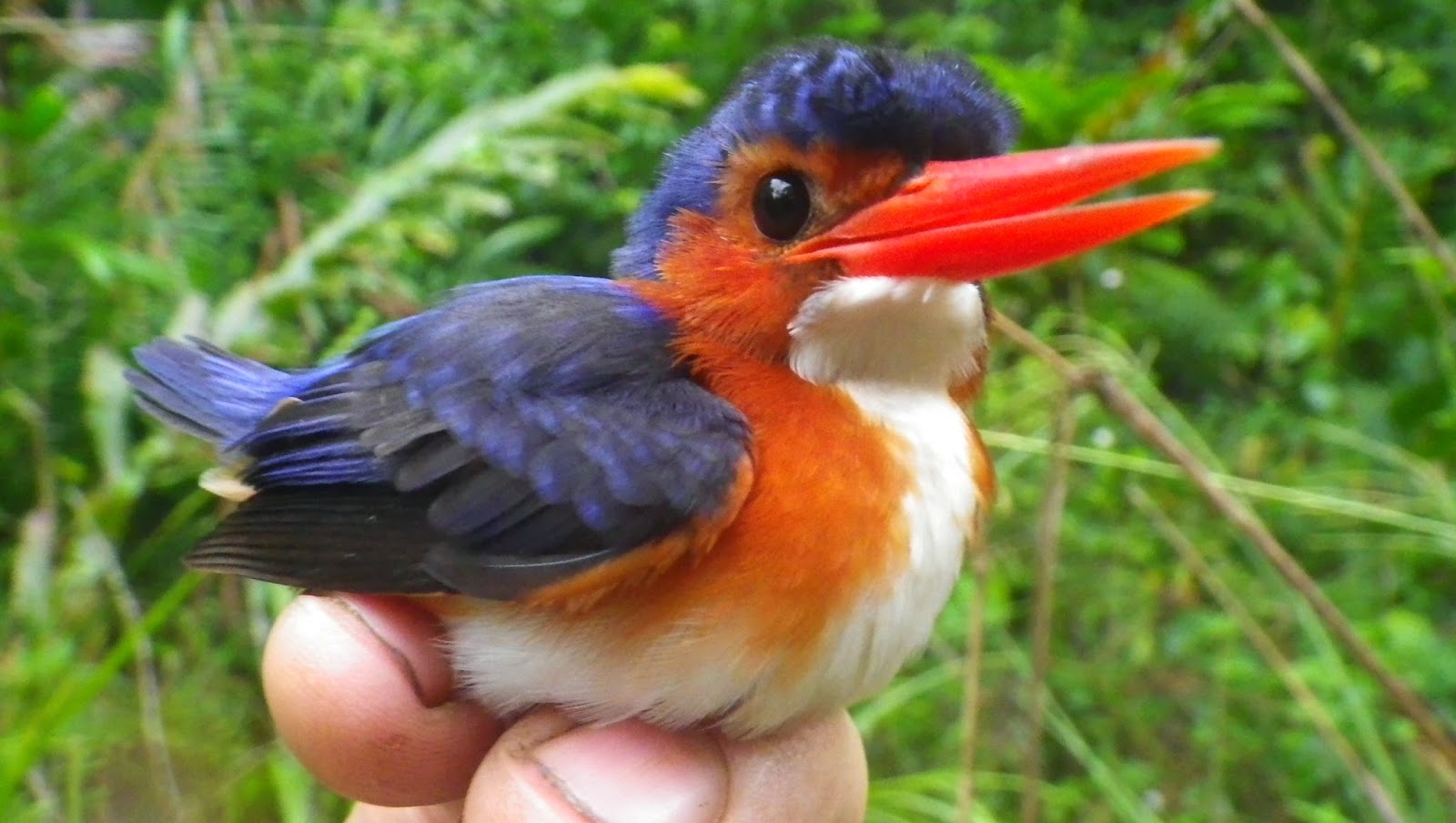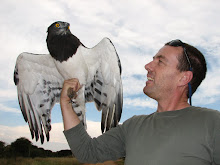A Bunch of Raptor Mad
Canadian Banders come to South Africa!
March 2014
Picked up an excited Nigel and his 5 trainees, Charlotte,
Amanda, Bronwyn, Maya and John at the airport and got out of town!
There was a huge weather system coming all the way down from
Angola with big rains predicted, so we very quickly turned the white vehicle
brown on the dirt roads.
We got 3 Black Shouldered Kites on the way, 2 on one trap! It’s
amazing how many of this species get ringed in this area and I still catch new
adults, it’s so tantalizing as to where birds go and come from!
There were loads of migrants about, Lesser-grey and
Red-backed Shrikes, A Wahlberg’s Eagle, several Steppe Buzzards, European
Bee-eaters roadside bushed noisy with calling European Marsh Warblers and hundreds
of Lesser Kestrels and Amur Falcons hunting over the fields. At one point a
huge flock of Black-winged Pratincoles flew north over the road, easily a
couple of thousand birds.
Netting first thing proved slow, Red-backed Shrike, Willow
Warbler, Arrow-marked Babbler and a few weavers. What was quite remarkable were
3 Mynah Birds on the garden lawn, feeding 3 juvenile Greater Spotted
Cuckoos! We set a sneaky 2 panel through
a small shrubbery, which the birds were going into cover in and eventually got
2 of the cuckoos! The spring traps did well here catching a few Magpie Shrikes.
Raptoring in the area produced a few birds, 2 Steppe
Buzzards (dropped for about 20!) a huge juvenile female Lanner, which came into
a Zebra Finch lure, a female Lesser Kestrel and a very long waited for Black
Kite!
Amanda was the lucky one to get
the Lanner, it had a load of Quelea mush all round its beak, so in good shape
at nearly 1kg!
The Steppe Buzzards were playing
their usual wary hard-to-catch selves, but the best result was the Black Kite.
Not many of them caught on a BC, it took 30 minutes of a stand-off between it,
a Pale-chanting Goshawk and a Steppe Buzzard. The PCG must have been ringed as
it unusually showed no interest in the mouse and eventually the buzzard took
off and the Kite saw its chance! (dopey juv!).
Owling in the night proved
frustration to say the least, we had a pair of Spotted Eagle Owls standing
guard over a Bal-chatri no more than 3 m away! A Barn Owl flew over the big net
a few times and the Pearl-spotted and Southern White-faced Owls, just shouted
back at the sound system!
Woodbush Forest
Heading north the next day, we
saw an adult male Montague’s Harrier, a ‘fall’ of some 20 Black Kites sitting
in the rain. We tried to tempt one of these northward bound migrants but only
succeeded in attracting a Black-backed Jackal!
We managed a Steppe Buzzard and a
Greater Kestrel on the way up and dropped for a load of Steppe Buzzards and one
each of Black-chested and Brown Snake Eagles. At Woodbush we saw a couple of
uncatchable Long-crested Eagles, and got to the lodge to set up nets.
At dusk we were surprised by a
European Hobby feeding over the field in front of the lodge! Later on we had 4
(2 pairs) of Wood Owl calling back at the sound system!
It was very wet and foggy, but we
managed a few Lesser Double-collared Sunbirds, Dusky Flycatchers, Chorister
Robin, Cape Robin Chat, Bar-throated Apalis and Cape White-eyes (the dark
eastern race).
Went out on a raptor run, very
hard conditions, rain hampered things and we unsuccessfully dropped for 12
birds, mostly S Buzzards, but also Jackal Buzzard and a 2 Forest Buzzards. We
were plagued by showers for the rest of the day so in the evening set up
another owl net with the stuffed Spotted Eagle Owl decoy. Which worked very
well producing a lovely sub adult Wood Owl! There was no doubting who wanted to
band this bird the most and the look on Charlotte’s face said it all!
Heading north still, we got a
lovely Long-crested Eagle, almost missed it in the Fog! We also caught a couple
of adult (!) Steppe Buzzards and at one point had 5 jackal Buzzards in the air
over 2 traps! Eventually we managed to get one down near a trap. The bird
behaved most strangely, walking up and down the track, eating a few squashed
beetles and grasshoppers, until it eventually wound its way back to the trap
and very half-hardheartedly managed to get itself caught.
Well it was ringed! This would
explain its behavior, but looking up the number we discovered it was ringed
some 50km away by Nigel 2 years ago!! What were the chances?!
Blouberg nature Reserve
Getting into ‘dryer’ thornbush,
we picked up 4 PCG’s and dropped for a juv Gabar Goshawk which we would have
caught if its sibling had not came in and started a fight about it, both birds
disappeared!
Saw a couple of snake eagles and
had a Brown get off a trap (so frustrating) and got to camp to set nets. Later
that night we got an African Scops Owl.
Netting was very slow, this rain
and cold weather making it very difficult to catch good numbers. Caught a pair
of Striped Kingfishes, Grey-headed Bush Shrike, Southern Black Tit, African
Paradise Flycatcher, Golden Breasted Bunting and 3 White-crowned
Helmet-shrikes.
Raptoring produced a couple of
Steppe Buzzards, lost a Black-chested Snake Eagle off the trap. There are so
many Steppe Buzzards in the area, all waiting for the right conditions to head
north on a broad front.
Owling that evening made up for
the day’s raptoring producing a White-faced Scops Owl, Pearl-spotted Owlet and
a nice big Spotted Eagle Owl!
Mpangubwe Limpopo River and Zimbabwe Border
Moving off the next morning we
struggled to find birds, but eventually came across a preening Black-chested
Snake Eagle. It took ages to get the bird to see the trap (stuck right under
its beak!) and eventually got the bird! Maya was a very happy camper to have
ringed it!).
That evening we watched a great
passage of birds moving north out of the weather system. There were Verreaux’s
Eagles up in the ‘kettle’ of raptors which included many Steppe Buzzards,
Wahlberg’s Eagles, Montague’s and Pallid Harrier, a flock of some 100 Amur
Falcons, 2 Peregrines and a Black Stork!
We were restricted by where we
could go as so many roads were washed out after torrential rain all night. We
did manage to get a Black-chested Snake Eagle and an immature African Hawk
Eagle which Amanda was very happy to ring! We also got a pair of Dark-chanting
Goshawks and a Shikra. We were now seeing quite a few more snake eagles and had
a couple come in and off traps. Saw a pair of huge Kori Bustards in a field.
Tried for owls and nightjars in
the evening, but the rain came in and it hammered down all night. So much so a
Python got washed off the roof!
Making our way west along the
Limpopo Valley, we dropped for a couple of Wahlberg’s Eagles, but too wet and
soggy for any serious interest but caught another immature African Hawk Eagle.
The long anticipated Barn Swallow
roost which numbered over 1 million 2 years ago, failed to deliver. We set a
line of nets along the maize field and managed only 20 birds out of a possible
100. The farmer told us the main bulk of birds had moved out in front of this
weather system!
Raptoring in the area is always
interesting and leaving the camp we saw an adult Martial Eagle at the gate,
managed to get a trap down for it and it came closer to look, we were unsighted
and so getting closet to drop another trap, the bird flew!! Agonising! A bit
later we came across a pair of Hawk Eagles on a pylon and dropped for them
eventually the male came in which we got, and whilst we were processing him,
the female came in but too trap shy.
We were seeing plenty of birds
now, Wahlberg’s, and Snake Eagles, we managed to catch 2 BC and 3 Brown Snake
Eagles, one a big bird of 2.2 kgs. At one point in the morning 2 flocks of 300
and 600 White Storks came over the road all heading north.
Back at the camp the Limpopo
River had begun to overflow! I decided to park our vehicle up on higher ground
for the night and just as well! In the morning we had to enlist the help of the
farm workers to get all our equipment out, and wade across the flooded
landscape to the vehicle!
In fact the whole area was put
under emergency flood measures. The Lapalala River was over the bridge which we
had crossed the day before! Getting to our next camp was out of the question.
We decided to head south and get out of the danger area, not before catching
another adult BC Snake Eagle in the same tree the Martial had been in!
On the way south we came across
another Martial, a huge white juvenile on a pole. We managed to get a trap down
for it and eventually the bird came in and hovered (!) over the trap and landed
next to it. With hearts in mouths we waited, the bird took one lunge at the
trap before a vehicle came along and flushed the bird. That was that, sooo
frustrating! Later on that day we were rewarded with my first ever Brown Snake
eagle ‘double header’! We dropped for one bird which came in immediately, but
then a second unseen bird came in too, and we caught both!
Summary
Overall we did ok considering the
wet conditions, the rain had flooded most of the province and we did well to
avoid serious stranding’s with only a few detours and had to retrace our tracks
once or twice.
We ringed 52 birds of prey in
total, including 10 Steppe Buzzards, 7 Pale-chanting Goshawks, 3 Shikra, 3
African Hawk Eagles 7 Brown and 6 Black-chested Snake Eagles.
Altogether we got 63 species of
160 individuals.


































